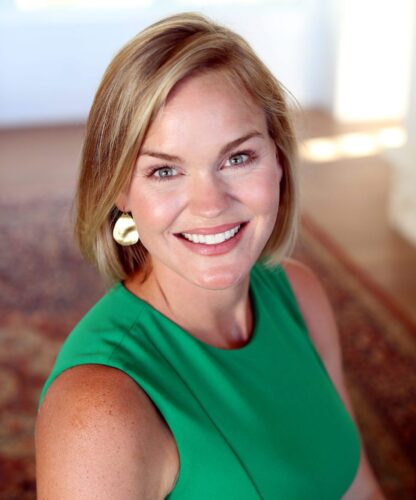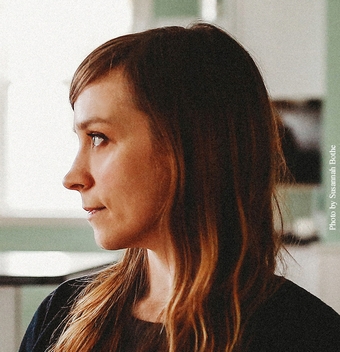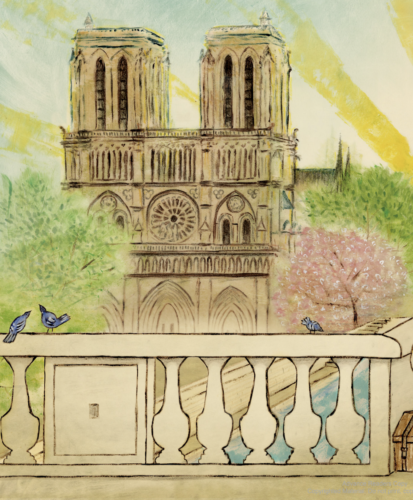The Bees of Notre Dame: A Dual Interview with Meghan P. Browne and E.B. Goodale
One of these days I’m going to rank my favorite types of children’s literature. Some odd little corner of my brain honestly thinks that this would be fun. I would spend an inordinate amount of time figuring out where Board Books fall in relation to Graphic Novels or Poetry even. It’s a hard call. Maybe I’d put Nonfiction Picture Books high on that list. There are so many things I love about them these days. I love how they tell me stories long before the adult book world ever comes to them. I love how they can drill down into interesting subjects in a wide range of ways. And when I see a book like the upcoming The Bees of Notre Dame by Meghan P. Browne and E.B. Goodale (out October 17th) it certainly shoots the genre to the top of the list.
Tomorrow (April 15th) marks the anniversary of the first that ripped through Notre Dame four years ago. Today, we’re looking at a picture book that highlights one of its success stories. And if that teaser isn’t enough to entice you (are you made of stone?!?) this description might:
ADVERTISEMENT
ADVERTISEMENT
This lyrical, poignant nonfiction picture book tells the fascinating story of the honeybee colonies that lived on the roof of the Notre-Dame Cathedral in Paris and survived the devastating 2019 fire.
High above the bustling streets and gardens of Paris is a little-known wonder: a cluster of beehives. They sit atop the roof of the Notre-Dame cathedral, lovingly tended to by a beekeeper named Sibyle. But when fire broke out in the catherdral in 2019, the bees almost didn’t make it. Firefighters battled heat and smoke, carefully spraying their hoses around the hives, pumping in water from fireboats on the Seine, and, miraculously, they survived.
Meghan P. Browne and E. B. Goodale imbue the story of Notre-Dame’s bees and the fire that almost killed them with great hope. After the fire, there is rebuilding to be done, but with hard work and collaboration, perhaps the cathedral can be restored after all. From the rooftops of Paris to the intricacies of a beehive, here is a moving picture book about resilience in the face of disaster.
Oooo! I’m so excited! I have so many questions to ask! And best of all, I get to ask them of both of the creators.
Betsy Bird: Hello to both of you today! I’m so pleased to be talking to you about this book today. And what a book it is! Meghan, let’s start with you. Tell me a little bit about where this all came from. How did you first hear about the bees of Notre Dame? And did you immediately know they’d be a good subject for a book?

Megan Browne: Hi, Betsy! I am so glad, too! Thank you for your kind words. This book idea came just a couple of days after the fire at Notre-Dame. On Good Friday in 2019, my kids were off from school, and I got a barrage of texts and emails from friends who know that my husband and I keep honeybees. Everyone was sending me a link to this story that USA Today was running about the rooftop honeybees at the cathedral. My agent, Alyssa Eisner Henkin, who I’d signed with just a few months before, had been asking me if I had a bee story in my bonnet. When I forwarded the article to her to ask if she thought this might be the seed of my bee story, Alyssa asked me how soon I could get it to her. I knew right away that I needed to get to Paris. I’d never been, and I felt like I had to be there in the aftermath of the fire in order to properly write this book.
BB: Ah, I weep for you. Indeed. And E.B., thank you so much for speaking with me too. How did you come to be attached to Megan’s project?
E.B. Goodale: As most projects do, it came to me through my agent. It was right at the beginning of the pandemic shutdown, and I loved the manuscript instantly, but was hesitant to accept it at first because I knew I needed to go to Paris to do the book justice and I wasn’t sure when we’d be able to travel safely again! Luckily, we were able to work out a schedule that felt reasonable and I did, eventually, make it to Paris!
BB: I enjoy a lot of what you folks are telling me, but particularly the fact that it necessitated Parisian vacations. Meghan, could you tell me a little bit about some of that research that went into this project? As I understand it you were able to get out to Paris just a week after the fire. What did you see while you were there?
MB: My husband is a commercial airline pilot, and I was able to use his employee pass-sharing privileges to hitchhike to Paris on an open seat just a week after the fire. This was the first time I’d left my young kids to travel internationally and the first time I’d traveled alone in over a decade. By the way, did I mention that I don’t speak a lick of French? My kids came down with a stomach virus right before I left, and I almost called off the trip worried that I’d get sick mid-flight. While I was flying over the Atlantic, I googled the beekeepers mentioned in the article, and I emailed them to beg for an interview. After a few rounds of politely turning me down, they kindly acquiesced, and I got to meet Nicolas Géant and Sibyle Moulin at their warehouse in Buc, just outside Versaille. Nic and Sibyle generously allowed me to shadow Sibyle during her rounds taking care of bee colonies atop balconies and rooftops all over Paris. There were some corporate offices and private residences that I wasn’t allowed to enter, but it was a truly magical experience. Notre-Dame was (and is) still closed to tourists, so I spent a lot of time in public gardens across the city looking for signs of spring, walking though markets, and visiting smaller churches to get a glimpse of their beauty. It was important to me to get close to the cathedral grounds to see, smell, and hear the way the city was mourning and rebuilding in the days right after the catastrophe. It was a whirlwind three-day trip, but I felt confident that I had gathered what I needed to write a draft.

BB: E.B., I know that like Meghan you too were in Paris as well. What kind of research did you do out there? What was your particular trip like?
EBG: It was so fun and very magical to travel across the world just to follow a story. I set up meetings but also simply wandered and soaked up the atmosphere. I learned a lot about Notre Dame itself from a private tour with a religious history expert, I retraced the steps of the firefighters by finding their docked fireboats on the Seine and using the packet of information they sent me ahead of time, and went out to the beekeeping headquarters outside the city to spend the day with Sibyle, the beekeeper who tends to the hives at Notre Dame. I traveled with a friend who is also an artist, so we spent a lot of luxurious time sketching together around the city. I came home feeling immersed with a solid foundation of how to bring the story to life.
BB: Careful. You two are going to make whole swaths of book creators try to find their own French angles on their book proposals. Meghan, the way the book is written, the story isn’t told from a single perspective but rather from an omniscient narrator. Did you ever toy with making the book first person at all, or was this the way you wanted to tell it from the start?
MB: I wrote many, many drafts of this story. I lost my dad unexpectedly during the time that I was trying to write the manuscript, and one of the early drafts was so grief-laden that it was completely unfriendly to a child audience. In one particularly beloved version, the cathedral was narrator. I was able to finally wrap my brain around the final manuscript while working under the guidance of Jane Kurtz with Sidura Ludwig and Kathy Fork in the Picture Book Intensive at the Vermont College of Fine Arts. When I came home to Austin after residency in snowy Vermont (almost a full year after the fire), I got myself to church extra early one Sunday, sat alone in a pew, and was finally able to envision what would become the book that E.B. Goodale and I have created together.

BB: Speaking of which, E.B., as far as I know (and feel free to correct me here) this is the first nonfiction book you’ve worked on before. How does a project like this differ from a wholly fictional one? Are there different concerns or things to look out for? How did you tackle it?
EBG: It is my first nonfiction book. It was so different and really a challenge. I wanted to make sure everything was accurate but also felt fun and flowed naturally with the text. I relied on research and reference much more than I usually do and I spent a ton of time refining sketches before I felt comfortable going to final art. With a structure as famous as Notre Dame, I was acutely aware of the eyes of the world…something I don’t usually think about at all!
BB: And Meghan, this isn’t your first nonfiction picture book, but it’s a small departure from biographies. In a way, it’s a mix of science, history, and architecture (and even travel, considering the location). Was there anything you hoped to include in this book that you ultimately had to cut out?
MB: There were so many details that I loved that didn’t make the cut, and I think that’s why drafting felt so hard. Some of my favorites are the ancient trees that were harvested to make the roof, my girlhood hero Joan of Arc’s connection to the building, Victor Hugo’s language that compared the cathedral to a beehive, and other detailed ways that the cathedral has changed over centuries. Did you know Napoleon made the bee the symbol of the French empire because of the animal’s diligence, orderliness, and connotations of immortality and resurrection? I especially loved the opportunity to do on-location research, and I’m so grateful that Emily felt called to go to Paris, too.
BB: And speaking of which, E.B., taking on a book of this sort means taking a deep dive into architectural details. You render Notre Dame so beautifully in these pages too. Was rendering the building accurately a challenge in any way (particularly when parts of the original Notre Dame are still covered in scaffolding).

EBG: Thank you for saying that! This was, by far, the most intensive set of illustrations I’ve ever worked on. For my own sanity, and because it tends to be my style anyway, I wanted to render Notre Dame a bit loosely, while still capturing it’s essence. In retrospect, I wouldn’t say my illustrations look “loose” by any means, but they still omit MANY details of the building. It is such a densely intricate structure with stylings being slightly different in each place they occur. I did my best to pay attention to the idiosyncratic qualities and capture them for the keen eyed reader. I did some sketching in-person, but luckily for me, it is a very well documented building, so there is no shortage of reference material for the sections covered in scaffolding. While I was in Paris, I also spent a lot of time at the exhibit at Cité de l’Architecture where the restored steeple statues and fallen rooster were on display, as well as many old photos, drawings, and maquettes of the building going back through time. It was an exhibit abundant with valuable material for me!
BB: That reminds me. Meghan, here’s one question that’s just for me. How did the bees get on top of Notre Dame in the first place? Do you know who came up with the idea to do beekeeping up there?
MB: The beehives were installed above the sacristy at the cathedral in 2013. Paris has a program that encourages residents, corporations, and other real estate owners to keep bees on rooftops and balconies in support of pollination and biodiversity in urban areas. Many organizations and individuals hire professional beekeepers like Sibyle to tend to their colonies. If you ever find yourself walking the streets of Paris, look up! You might be surprised to see a balcony hive, or a fully-suited beekeeper caring for colonies of bees on a rooftop.
BB: Well, that’s just awesome. You know, my favorite part of the book to look at is actually the endpapers. On the front endpapers you see this view of the cathedral from the top before the fire, and another shot from after, with all these fun details in the margins. E.B., was that your idea from the start or did it come to you later?

ADVERTISEMENT
ADVERTISEMENT
EBG: I had a lot of fun with the endpapers! I thought of something like them from the start, but then as I pieced the images together, I realized that they actually felt necessary. Even for myself, it took me days of being in Paris before I even wrapped my head around the exact location of the hives before the fire. I knew they were on the sacristy, but even that has 3 separate roof sections. Then Sibyle told me that the hives had been moved during construction, which seemed like really important information to fill out the story. If only for that one detail, I liked the idea of the map. But then there were so many other little things that I discovered along the way that felt useful and fun to include. I think the endpapers help ground the reader, or at least, that was my intention.
BB: All right. Well, finally, this one is for the both of you. What else do you have coming up next?
MB: In the very near future, we are expecting baby goats on the Honey Browne farm, and I am very excited about that! In between all of the springtime happenings at my house, I’m working on a middle grade novel set in west Texas, and I have a few other non-fiction picture book manuscripts I’m noodling around with.
EBG: After I finished this book, I decided to take a little breather between projects for the first time in 8 years. I do have a couple books in the oven, but I’m not quite ready to talk about them yet. Stay tuned!
And stay tuned we shall! I want to thank Meghan and Emily for taking the time to speak with me today. The Bees of Notre Dame comes out October 17th of this year. Keep your eyes and ears peeled for it!
Filed under: Best Books, Best Books of 2023, Interviews
About Betsy Bird
Betsy Bird is currently the Collection Development Manager of the Evanston Public Library system and a former Materials Specialist for New York Public Library. She has served on Newbery, written for Horn Book, and has done other lovely little things that she'd love to tell you about but that she's sure you'd find more interesting to hear of in person. Her opinions are her own and do not reflect those of EPL, SLJ, or any of the other acronyms you might be able to name. Follow her on Twitter: @fuseeight.
ADVERTISEMENT
ADVERTISEMENT
SLJ Blog Network
Name That LEGO Book Cover! (#53)
K is in Trouble | Review
Fighting Public School Book Bans with the Civil Rights Act
Take Five: Middle Grade Anthologies and Short Story Collections
ADVERTISEMENT







